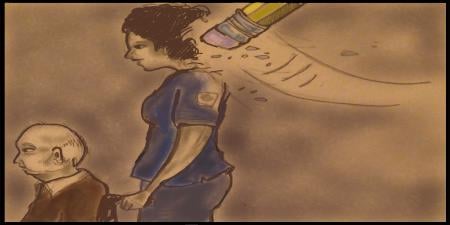Abstract
Team-based care is a strong focus and narrative in medical and health education and within health care systems. Yet it is essential to consider that there are vast differences in power, education, compensation, and job security among team members in most health professional teams. How should clinicians of status play a role in advocating for lower status members of their health care teams, and why is that role important in improving equity within clinic walls and equity and better patient care for the communities they serve?
Roles of Physician Leaders
At its core, team-based care is providing health services to “individuals, families, and/or their communities by at least two health providers who work collaboratively with patients and their caregivers … to accomplish shared goals within and across settings to achieve coordinated, high-quality care.”1 This approach is an attribute of patient-centered care.2 Team-based care, which can follow different paradigms and involve different stakeholders, has been shown to improve clinician workflow and the quality (via patient safety and satisfaction), effectiveness, and value of patient-centered care when integrated intentionally.3
Teams require leaders, but what exactly does the term physician leader entail? The American Medical Association (AMA) defines physician leadership as “the consistent use of a physician’s leadership knowledge, skills and expertise necessary to identify, engage and elicit from each team member the unique set of contributions needed to help patients achieve their care goals.”4 In this context, the term team members applies to those with high levels of direct clinical care such as “physicians, nurses, physician assistants, pharmacists, social workers, case managers and other health care professionals.”4
Per AMA guidelines, the physician’s role is to understand and utilize the strengths of each team member to create a high-functioning team. But is that enough? While health care team members may work in close physical proximity, they often—even when working in the same team and caring for the same patients—inhabit starkly prescribed places in the traditional health care hierarchy, which, historically, has been systemically racialized and gendered. Within this system, physicians tend to maintain the highest status and position of power.
How can physician leaders support colleagues who are not accorded the same level of institutional power and status? We argue that physician leaders of the future should utilize their status to advocate on behalf of their health care team members—especially those who occupy lower positions of power and status—in the interests of justice and for the benefit of clinical practice, patient care, and medical education.
Who Makes a Health Care Workforce?
Within the larger health care “team” there are many smaller workforces. For example, core teams include nurses, dentists, pharmacists, doctors, assistants, and case managers; ancillary teams include cleaners and domestic staff; and support services include secretaries and executive management.5 As such, a variety of specialties, educational backgrounds, compensation levels, and job security levels are represented in the health care team.
Racial and ethnic differences also starkly divide members of health care teams. While health professions are less racially and ethnically diverse than the general US population,6 they are becoming increasingly racially and ethnically diverse, although the majority of that diversity has occurred within occupations that require less education and training—such as aides, assistants, and technicians—and, as a result, offer lower wages, job security, status, and power.7 Workers vital to the effective functioning of a health care organization (eg, nursing assistants, phlebotomists, medical assistants, housekeeping and environmental services workers, and cooks), who are often women and disproportionately people of color, have a median pay of $13.48 an hour7—short of a living wage. According to the US Bureau of Labor Statistics, home health aides had a median annual wage of $29 430 in 2021, which was lower than the median annual wage for all occupations ($45 760).8 More generally, workers in home health and personal care, among the fastest-growing occupations, earn a median hourly wage of $11.57; 20% of these workers live in poverty, with over 40% relying on some form of public assistance or safety net program.7 While the lower pay of health support workers coincides with their lower level of education and training—and inequitable access to said education and training—this pay differential has real implications individually, in the workplace, and within teams that affects personal finances and family security, job stability, communication, trust, respect, teamwork skills, and a positive team attitude.9
Physicians as Advocates
Given the importance of team-based care and the existence of disparities within the health care team, we argue that physicians have a duty not only to coordinate among team members but also to advocate for them as part of helping patients meet their care goals. Advocating for improvements in working conditions and benefits and including the voice of health care workers with lower wages and less power will not only benefit those workers directly but also benefit patients and communities as a whole. Although workers with low incomes and little power have not been included in many studies of health care safety,10 studies of high-reliability organizations in other fields show that buy-in is required from the vast majority of workers to create a culture of safety.11 A true team-based care model allows everyone on the team to reach their full potential, with the result that patients experience excellence in all their interactions with the health care system. Expanding this approach to consistently include more team members—such as transport staff, medical assistants, and home health aides—is necessary. Modern health care is enormously complex, and if any part of the system is disturbed—be it the lack of paper in an emergency department or no one to transport patients to a procedure—patient care suffers.
Equity for health care workers with low wages and little power will also result in increased equity for the groups and communities to which they belong.
Luckily, physicians already have many tools that can be used in these efforts, as existing advocacy strategies can inform physician support for health care workers with low wages and little power. On a legislative level, physicians have experience advocating for fair wages for themselves and other direct-care team members. The AMA has multiple efforts targeted toward higher physician payment rates,12 and physicians have also voiced opposition to proposed legislation to limit nurse wages.13 Physicians could take these initiatives one step further and advocate for better wages and working conditions for health care workers with low wages and little power, especially given that many of these workers live in poverty.7 For instance, while supporting their case for hazard pay, one group of residents and fellows also argued in favor of hazard pay for all frontline health care workers.14 While advocating for proper personal protective equipment (PPE), physician groups have not limited their efforts to physicians but instead extended them to all health care workers.15
Advocating for workers with low wages and little power could have benefits in addition to improving working conditions of those employees. One physician research group evaluated its organization’s Clostridium difficile infection prevention strategy through the lens of environmental services workers’ experiences, which allowed it to identify additional strengths and weaknesses of the program.16 Quality improvement projects require interdisciplinary teams, and “the people who do the work need to be the ones to change the work.”17 Environmental services workers are directly involved in implementing Clostridium difficile prevention protocols,18 so formally including these workers in interdisciplinary teams responsible for quality improvement projects could facilitate discovery of new solutions to a problem that not only endangers patient safety but also unnecessarily increases health care costs.19
Equity for health care workers with low wages and little power will also result in increased equity for the groups and communities to which they belong. As racial and ethnic minorities tend to have higher representation in low-wage and low-power fields, advocating for these workers also entails advocating for the historically disadvantaged communities to which they belong. Further incorporating these workers’ voices and perspectives in advocacy efforts to improve their professional and financial security could facilitate these workers’ efforts to better connect health care systems to hard-to-reach communities since they would perceive themselves to be valued and vital employees of their organizations.
Medical School Leadership Training
Improving and changing our health care system involves educating and training physician leaders of the future to view their responsibilities more holistically.20 Education,21 training, and exposure to the expanded role of physician leadership can be highly instrumental in developing future physicians’ understanding and appreciation of health care teams and acceptance of their role as an advocate for that team and the larger community served.
Some medical schools already have formalized coursework in equity, advocacy, and team-based care, along with interdisciplinary sessions involving students and practitioners across the health professions. Examples include the Certificate in the Science of Health Care Delivery required of all medical students at the Mayo Clinic Alix School of Medicine, which includes in its curriculum physician leadership, team-based care, health care disparities, and policy advocacy, and the University of Texas at Austin Dell Medical School’s incorporating interprofessionalism, leadership, and social determinants of health concepts in medical education.22,23,24 These programs are innovative and necessary. As they grow and mature, these programs could include the importance of physician leadership and advocacy for various members of the health care team so that students enter the workforce ready to do this essential work.
COVID-19
The COVID-19 pandemic has highlighted the demands placed on frontline health care workers as well as the disparities in outcomes experienced by communities of color in the larger society. The pandemic has demanded an “all hands-on deck” approach and unremitting commitment to patient care from health care teams and workers across the nation for over 2 years. The need for a high-functioning and coordinated health care system is apparent like never before. Yet for health care team members with low wages and little power, the strain of the pandemic, inadequate safety measures, and burdensome caregiving responsibilities, together with their desire for career growth and better compensation and benefits, has led to high rates of burnout.25 Home health care workers, who were vital during the pandemic in providing care outside the hospital setting to patients who were elderly or disabled, not only continued to experience lower wages but also reported delays in receiving PPE.26 Environmental services workers, who are directly responsible for sanitizing hospitals during a pandemic, have described not receiving hazard pay14 and feeling “overlooked and deprioritized, even expendable.”7 Advocating for workers with low wages and little power, especially people of color and populations hit hardest by COVID-19, offers an important opportunity to increase these workers’ trust and to educate and assist members of their communities in navigating health care during the pandemic.
Conclusion
As we consider how to move toward the health care system we need, it is critical to consider the realities, needs, and power dynamics of those who make up that system. As professionals of high status, physicians must utilize their status and voice to improve the conditions and status of colleagues who compose larger health care teams. For this to happen, we must expand the concept of physician leadership to include advocacy for not only the communities served— especially those that are lower income—but also other health care professionals—specifically, those who earn lower wages and occupy a lower place in the hierarchy of the health care system. Such advocacy requires innovative, bold, and brave steps forward in education, workplace norms, and culture—and physicians are up to the challenge.
References
-
Naylor MD, Coburn KD, Kurtzman ET, et al. Inter-professional team-based primary care for chronically ill adults: state of the science. Paper presented at: ABIM Foundation Meeting to Advance Team-Based Care for the Chronically Ill in Ambulatory Settings; March 24-25, 2010; Philadelphia, PA.
- Davis K, Schoenbaum SC, Audet AM. A 2020 vision of patient-centered primary care. J Gen Intern Med. 2005;20(10):953-957.
- Schottenfeld L, Petersen D, Peikes D, et al. Creating patient-centered team-based primary care. Agency for Healthcare Research and Quality; 2016. AHRQ 16-0002-EF. Accessed July 11, 2022. https://www.ahrq.gov/sites/default/files/wysiwyg/ncepcr/tools/PCMH/creating-patient-centered-team-based-primary-care-white-paper.pdf.
-
Physician-led team-based care. American Medical Association. Accessed April 5, 2022. https://www.ama-assn.org/practice-management/scope-practice/physician-led-team-based-care
- Babiker A, El Husseini M, Al Nemri A, et al. Health care professional development: working as a team to improve patient care. Sudan J Paediatr. 2014;14(2):9-16.
-
Salsberg E, Richwine C, Westergaard S, et al. Estimation and comparison of current and future racial/ethnic representation in the US health care workforce. JAMA Netw Open. 2021;4(3):e213789.
-
Kinder M. Essential but undervalued: millions of health care workers aren’t getting the pay or respect they deserve in the COVID-19 pandemic. Brookings Institution. May 28, 2020. Accessed October 7, 2021. https://www.brookings.edu/research/essential-but-undervalued-millions-of-health-care-workers-arent-getting-the-pay-or-respect-they-deserve-in-the-covid-19-pandemic/
-
Occupational Outlook Handbook: home health and personal care aides. US Bureau of Labor Statistics. Updated April 18, 2022. Accessed July 11, 2022. https://www.bls.gov/ooh/healthcare/home-health-aides-and-personal-care-aides.htm#tab-5
- Okpala P. Addressing power dynamics in interprofessional health care teams. Int J Healthc Manag. 2021;14(4):1326-1332.
- Weaver SJ, Lubomksi LH, Wilson RF, Pfoh ER, Martinez KA, Dy SM. Promoting a culture of safety as a patient safety strategy: a systematic review. Ann Intern Med. 2013;158(5, pt 2):369-374.
- Roberts KH. Some characteristics of one type of high reliability organization. Organ Sci. 1990;1(2):160-176.
-
AMA advocacy 2020-2021 efforts. American Medical Association. November 10, 2021. Accessed February 14, 2022. https://www.ama-assn.org/delivering-care/patient-support-advocacy/ama-advocacy-2020-2021-efforts
-
@Afzal4Gorton. Over 100 constituents, including nursing staff, doctors and patients, have written to me calling for the 1% cap on nursing pay to be scrapped. I have responded to them all promising to do all I can to ensure that nurses and public sector workers are paid a fair wage. #ScrapTheCap. December 14, 2017. Accessed May 31, 2022. https://twitter.com/search?q=%40Afzal4Gorton.%20Over%20100%20constituents&src=typed_query&f=top
-
Gross D. What happened when medical residents asked for hazard pay. New Yorker. October 8, 2020. Accessed May 31, 2022. https://www.newyorker.com/science/medical-dispatch/what-happened-when-medical-residents-asked-for-hazard-pay
-
Alam M, Hruza G, Swaminathan M. A national strategy on PPE is needed for both doctors and patients. Alliance of Specialty Medicine. September 23, 2020. Accessed February 12, 2022. https://asmspecialtydocs.medium.com/a-national-strategy-on-ppe-is-needed-for-both-doctors-and-patients-e0fa1d592b95
- Yanke E, Moriarty H, Carayon P, Safdar N. “The invisible staff”: a qualitative analysis of environmental service workers’ perceptions of the VA clostridium difficile prevention bundle using a human factors engineering approach. J Patient Saf. 2021;17(8):e806-e814.
- Silver SA, Harel Z, McQuillan R, et al. How to begin a quality improvement project. Clin J Am Soc Nephrol. 2016;11(5):893-900.
- Khanafer N, Voirin N, Barbut F, Kuijper E, Vanhems P. Hospital management of Clostridium difficile infection: a review of the literature. J Hosp Infect. 2015;90(2):91-101.
- Trybou J, Spaepen E, Vermeulen B, Porrez L, Annemans L. Hospital-acquired infections in Belgian acute-care hospitals: financial burden of disease and potential cost savings. Acta Clin Belg. 2013;68(3):199-205.
- Bai H. Modernizing medical education through leadership development. Yale J Biol Med. 2020;93(3):433-439.
-
How medical education is changing: policy priorities to improve our nation’s health. Association of American Medical Colleges. Accessed May 31, 2022. https://www.aamc.org/system/files/c/2/472906-howmedicaleducationischanging.pdf
- Starr SR, Agrwal N, Bryan MJ, et al. Science of health care delivery: an innovation in undergraduate medical education to meet society’s needs. Mayo Clin Proc Innov Qual Outcomes. 2017;1(2):117-129.
- Starr SR, Reed DA, Essary A, et al. Science of health care delivery as a first step to advance undergraduate medical education: a multi-institutional collaboration. Healthc (Amst). 2017;5(3):98-104.
-
Leading EDGE curriculum. Dell Medical School, University of Texas at Austin. Accessed February 14, 2022. https://dellmed.utexas.edu/education/academics/undergraduate-medical-education/leading-edge-curriculum
- Sinsky CA, Brown RL, Stillman MJ, Linzer M. COVID-related stress and work intentions in a sample of US health care workers. Mayo Clin Proc Innov Qual Outcomes. 2021;5(6):1165-1173.
-
Woods B. Home health-care workers in US at tipping point amid coronavirus outbreak. CNBC. April 14, 2020. Accessed April 5, 2022. https://www.cnbc.com/2020/04/14/home-health-care-workers-at-tipping-point-amid-coronavirus-outbreak.html



